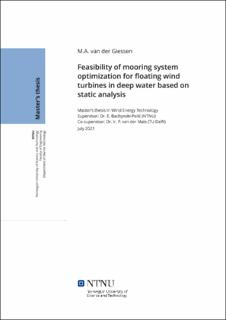| dc.description.abstract | The goal of this thesis is to investigate the feasibility of optimizing the mooring line characteristics of a semi-taut (chain – polyester – chain) mooring system in combination with drag embedded anchors for a 12 MW wind turbine supported by a semi-submersible in deep water, based on static analysis of the Ultimate Limit State (ULS) condition. The optimization objective is mooring system material cost. The hypothesis is that the ULS condition is design-driving. It is expected that static analysis optimization reduces optimization time and cost significantly in comparison to a full dynamic optimization. Additionally, a framework for a 6 wind turbine shared mooring farm concept is presented and challenges encountered are discussed. A gradient-based sequential quadratic programming optimization algorithm is implemented. Using static analysis results for optimization requires a relation between dynamic and mean mooring line tension. The initially implemented relation was found to be incorrect and showed that the relation is design- and condition-dependent. The optimizer reduces the mooring system costs by reducing the diameter of the mooring line segments, while the lengths of the polyester segment, bottom chain segment and anchor radius are increased to satisfy the constraints. The bottom chain segment is governing in material line material costs. The Minimum Breaking Load (MBL), pretension and anchor uplift constraints are the most critical constraints. The top chain segment reaches the lower limit as it does not significantly affect the properties of the mooring system and other constraints. A total cost reduction of 48% with respect to the initial design and an estimated simulation time reduction of 40% with respect to a dynamic simulation were achieved. Fatigue Limit State (FLS) analysis of the optimized system showed that FLS is design driving, as failure in the chain segments would occur within 1 year. To implement optimization based on static analysis a FLS constraint is required. A full dynamic FLS analysis is time consuming and a single degree of freedom model to estimate fatigue damage in the frequency domain based on surge motion and separation in frequency was implemented. The model was tested on two mooring system designs and compared to the simulated dynamic FLS simulation results. The model underestimates the accumulated damage consistently across the two designs and the segments. It significantly underestimates the damage accumulated in conditions with a long wave periods, which excite the natural frequency in heave, and showed that heave and pitch motion must be included for a more accurate damage accumulation estimate. The shared mooring farm concept design is challenging due to the eccentric placement of the wind turbine. Additionally, the reduction in the number of anchor lines requires increased anchor line strength, causing a vertical force imbalance at the fairleads of the semi-submersible. This force imbalance requires a very robust finite element solution for use in optimization, which was not achieved. Adjustments of the positioning of each turbine, distribution of ballast or dynamic ballasting in the semi-submersible may be required to investigate the feasibility of the designed concept. | |
